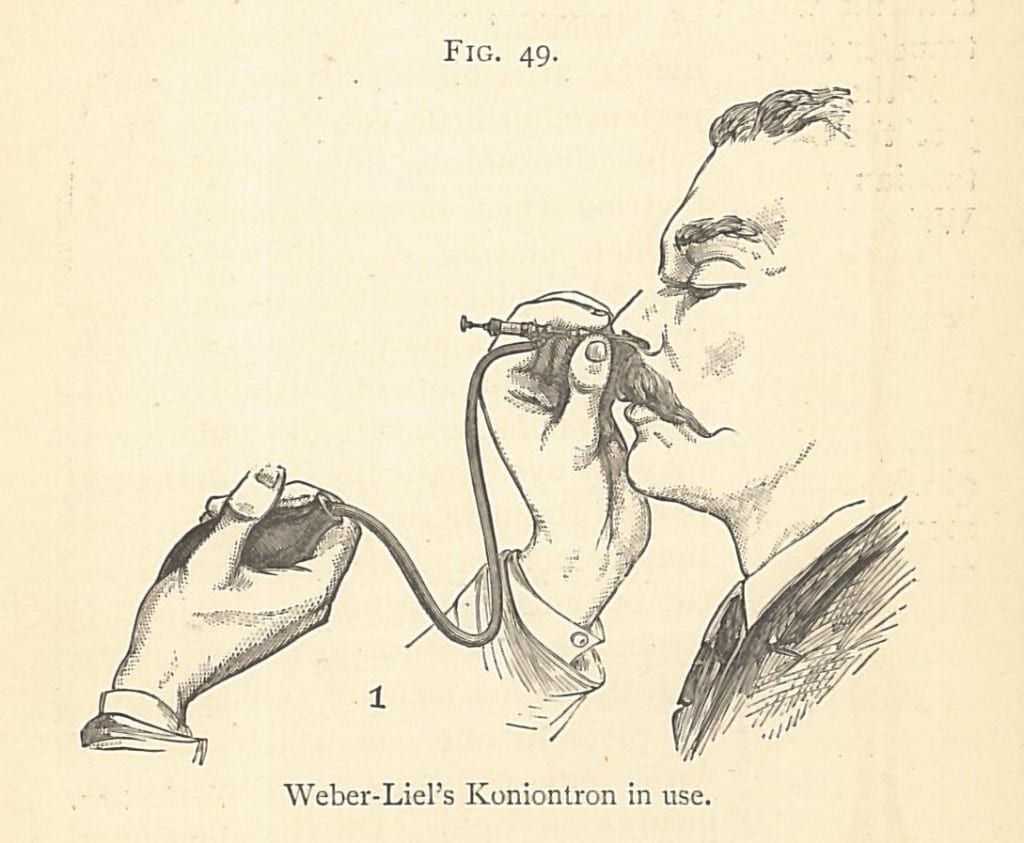“… we can easily mop the orifice …” – Macnaughton Jones and Tinnitus
By H Dominic W Stiles, on 12 February 2016
 The Irish otologist, gynaecologist and ophthalmologist Henry Macnaughton Jones was the son of Thomas Jones, a doctor from Cork (see obituary for what follows). He spent most of his early career locally, founding the Cork Eye, Ear and Throat Hospital, which was later known as the Victoria Hospital. Moving to London in 1883, he concentrated on obstetrics and gynaecology. He married when he was only twenty-two, and in the 1911 census we can see that there were three surviving children. His obituary tells us that “His Handbook on Diseases of the Ear and Naso-pharynx passed through six editions”.
The Irish otologist, gynaecologist and ophthalmologist Henry Macnaughton Jones was the son of Thomas Jones, a doctor from Cork (see obituary for what follows). He spent most of his early career locally, founding the Cork Eye, Ear and Throat Hospital, which was later known as the Victoria Hospital. Moving to London in 1883, he concentrated on obstetrics and gynaecology. He married when he was only twenty-two, and in the 1911 census we can see that there were three surviving children. His obituary tells us that “His Handbook on Diseases of the Ear and Naso-pharynx passed through six editions”.
 The book we are interested in today,Subjective Noises in the Head and Ears: Their Etiology, Diagnosis and Treatment was published in 1891. He dedicated the book to the pioneer ‘Father of Modern Scientific Otology’, Dr. Adam Politzer , who perused the text and “did not consider it necessary to add any notes to the work.” (Weir and Mudry, p.104, Macnaughton Jones, p.iv). Jonathan Hazell surveys this book, one of the few that cover tinnitus at that period. Macnaughton Jones follows on from Jean Marie Gaspard Itard (1775-1838), famous for his work with the ‘wild Boy of Aveyron’, as a pioneer of tinnitus research.
The book we are interested in today,Subjective Noises in the Head and Ears: Their Etiology, Diagnosis and Treatment was published in 1891. He dedicated the book to the pioneer ‘Father of Modern Scientific Otology’, Dr. Adam Politzer , who perused the text and “did not consider it necessary to add any notes to the work.” (Weir and Mudry, p.104, Macnaughton Jones, p.iv). Jonathan Hazell surveys this book, one of the few that cover tinnitus at that period. Macnaughton Jones follows on from Jean Marie Gaspard Itard (1775-1838), famous for his work with the ‘wild Boy of Aveyron’, as a pioneer of tinnitus research.
One method that Macnaughton Jones tried to treat tinnitus, was with a galvanic battery, though he was not convinced of its use. “It is uncertain in its effects, frequently causing grave aggravation of the subjective noises […] The dosage of it is difficult to measure. In the hands of those not accustomed to electrical manipulation it is a mosyt haphazard treatment in that form of nerve disturbance that requires technical skill in manipulation, and fineness of adjustment in appliance. (p.128-9)
Our copy is signed ‘with the author’s compliments’. The book is illustrated throughout with pictures of instruments that are laible to induce a shudder in those of a nervous disposition, such as Turnbull’s Eustacian Forceps, Eustachian Tube Electrode, Knife for Paracentesis Tympani, Mr Adam’s Septum Punch, a Nasal Saw and ‘The Author’s Nasal Shears’! In his chapter, Treatment – the Middle Ear, he discusses tympanic catheters –
If the surgeon is determine to try to inject the tympanum through the Eustachian tube, it is as well to use one of Weber-Liel’s tympanic catheters, with a Pravaz syringe. With this appliance, if the Eustachian tube be papent, we can safely inject the tympanum with the desired solution (vide “Handbook,” Fig. 46). With such forceps as that of Turnbull (Fig.50), we can easily mop the orifice of the Eustachian tube and the posterior nares with any solution we desire. I must confess that I do not of late resort to the use of chloride of ammonia vapour as frequently as I used to. Still, it is a remedy worth trying in those cases of tinnitus in which we have general naso-pharyngeal relaxation and accumulation of mucus in the naso-pharynx and the Eustachian tubes. It matters little which inhaler we use, provided we get the neutral fumes for imnhalation. Kerr’s inhaler was one of the first used, and it is a very simple one. […] If we desire to pump some of this vapour or that of iodiner into the tympanum through the Eustachian tube, we can easily do so by means of my autoinsufflating bag.
Some years since I had cigarettes made containing iodoform and eucaluptus for smikong purposes. I found that the iodoform was in great measure disguised by the eucalyptus, and more so, by vanillin or coumarin
I have had them made with a little crowsfoot leaf. These can be smoked through the nose, and some of the vapour may be passed behind the naso-pharynx, or by Valsalva’s method, into the tympanum.*
We also see illustrated below, massage techniques, and he says that while “I do not pretend to explain how it acts, but it has in some cases decidedly beneficial effect”.
Macnaughton Jones died in Hampstead, in 1918.
HENRY MACNAUGHTON-JONES, M.D., M.Ch., M.A.O., F.R.C.S.I. and Edin, Br Med J 1918;1:521 B doi: http://dx.doi.org/10.1136/bmj.1.2992.521-a (Published 04 May 1918)
Hazell, Jonathan, Tinnitus, (1987)
Weir, Neil, and Mudry, Albert, Otorhinolaryngology : an illustrated history (2nd ed., 2013)
Census 1911 Class: RG14; Piece: 601
 Close
Close




